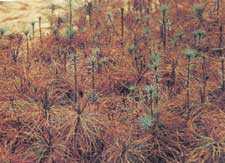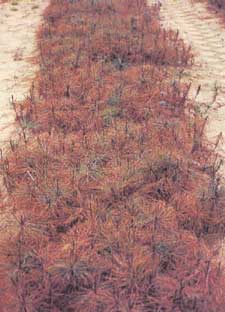Eastern White Pine Foliage BlightCharles E. Affeltranger - Plant Pathologist, Region 8, USDA Forest Service, Pineville, LA, and Cordell C.E., Anderson R.L., Hoffard W.H., Landis T.D., Smith R.S. Jr., Toko H.V., 1989. Forest Nursery Pests. USDA Forest Service, Agriculture Handbook No. 680, 184 pp. Hosts This foliage blight, associated with a species of Pestalotia, affects 2-0 and 3-0 seedlings of eastern white pine. It has not been observed on 1-0 white pine seedlings. Distribution This disease has been found in forest tree nurseries in North and South Carolina, Tennessee, Kentucky, and Virginia. A similar foliage disease is also reported from an Ohio nursery. Damage Mortality seldom occurs in the nursery, even on severely damaged seedlings. However, outplanting diseased seedlings results in significantly more seedling mortality and reduced growth than outplanting healthy seedlings. Diagnosis
On affected needles, small, shiny, black, fruiting bodies can be seen with the naked eye or with a 10 x hand lens. Under moist conditions, long, black ribbons of spores are exuded from the fruiting bodies. Individual spores are mostly five-celled (fig. 6-3) and are 22-32 x 7-13 microns. The middIe cells are dark, and the end cells, colorless. The Spores are ornamented with two to three slender appendages on one end and a single appendage on the other. The root system of infected seedlings may show various degrees of lateral and feeder root blackening and necrosis. Biology A species of Pestalotia, morphologically similar to P. funerea, has been the only fungus consistently isolated in pure culture from early and late symptomatic eastern white pine foliage. However, root disease fungi, including species in the genera Fusarium, Phytophthora, and Pythium, have been found in the soil and roots of white pines showing symptoms of foliage blight. These findings suggest that the foliage blight may be caused by a combination of factors: Pestalotia, the root disease fungi, and adverse environmental or soil conditions. No information is available to establish when infection occurs, but it appears to be correlated with extended periods of above average rainfall during the growing season. Little or no disease occurs during growing seasons with below average rainfall. The incidence of disease is highest and damage most severe in densely stocked seedbeds. Control Prevention - Use seedbed mulches that are free of fungus pathogens. Favor mulch materials such as hydromulch, sawdust, pine bark, and grain straw. Avoid planting white pine for windbreaks because white pines may provide a source of inoculum. Never ship diseased white pine seedlings between nurseries. Cultural - Plant at densities of fewer than 25 seedlings per square foot: high seedling densities increase moisture retention of the foliage and decrease air movement- conditions that favor the spread of the fungus. Irrigate during the early morning hours, when seedlings dry most quickly. This practice reduces the time that the seedling could be infected. Remove and destroy seedlings that have 50 percent or more of their foliage discolored or that are 25 percent or more defoliated, or both. More-intensive practices may be needed when culling white pine Christmas tree stock. As an alternative to culling, grow these seedlings another year as 3-0 seedlings and protect the new foliage with a fungicide. Store seedlings for as short a time as possible. Maintain storage temperatures at 40 to 45 F. Selected References Graham, J.E. Nichols, C.R.; Affeltranger, C.E. 1974. An evaluation of five fungicides for control of a white pine foliage disease at the Piedmont Forest Tree Nursery in South Carolina. Asheville, NC: U.S. Department of Agriculture, State and Private Forestry. Forest Pest Management. 7 p. Vermillion , M.T. 1950. A needle blight of Pine. Lloydia. 13: 196-197. |
Forest Pests: Insects, Diseases & Other Damage Agents |

|
|




